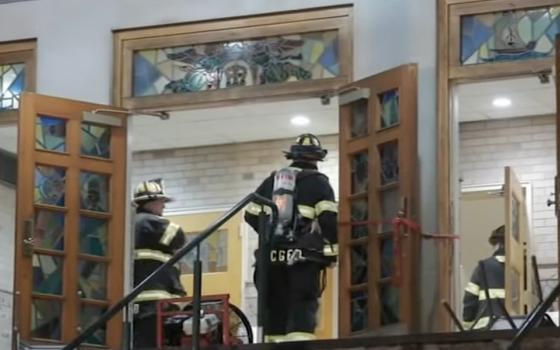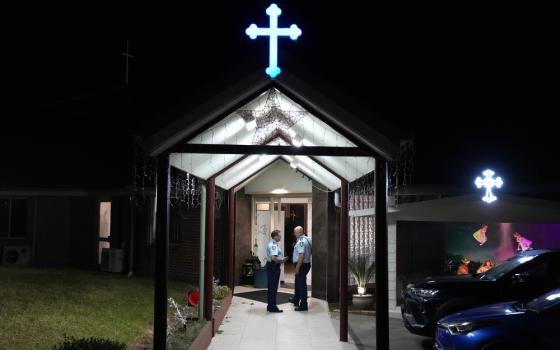
Glenmary Fr. John Rausch has led tours in the Appalachia region for several years to call attention to a devastating method of coal extraction called mountaintop removal. A recent tour ended on a mountaintop in eastern Kentucky where an assortment of interfaith leaders signed a joint statement calling their respective faith communities to act to stop the practice of mountaintop removal.
They also pledged to examine how their own lifestyles are driving this environmental disaster -- and global warming -- by the constant demand for cheap electricity from coal.
Rausch directs the Commission for Justice and Peace for the Lexington, Ky., diocese and the Catholic Committee of Appalachia, and he writes a syndicated column on faith and economics that appears in over 20 Catholic newspapers reaching over a half-million homes each month. Rausch has taught locally and internationally on sustainability, social development, worker rights and Catholic social teaching. In 2007 he received the USA Teacher of Peace Award from Pax Christi USA.
NCR: How did you get involved in activism to counter mountaintop removal?
Rausch: I’m a member of the Glenmary Home Missioners. We minister to rural America. My territory is eastern Kentucky.
In 2002, I got a call from a minister in McRoberts, which is a small coal town located in the Cumberland mountains in eastern Kentucky. That town was built for only one reason, that of housing the men brought in to mine the coal field. The mines themselves long since gave way to the new coal mining process -- mountaintop removal.
McRoberts hadn’t had a flood since 1927, then there were five major floods in 18 months.
In 1998 Tampa Energy Company began clear-cutting all the vegetation then blasting away the mountain ridges above the town, filling the nearby valleys with debris. Deforestation and constant blasting from the mountaintop removal operations had sent the community into severe economic decline. Foundations of homes that had been stable for decades were cracked; homes and gardens were washed away in flash floods. Families were displaced. Insisting that it was an “act of God,” the energy company and government inspectors took no responsibility for the suffering of the people of McRoberts.
In response to this, in December 2002, representatives of the faith community and environmentalists across Appalachia gathered atop a mining site in Letcher County near McRoberts to voice our concern over the loss of mountains and community. The protest site overlooked the wreckage of the recently flooded town. We called it the “Prayer on the Mountain.”
The event was aimed at educating folks that protecting God’s creation by stopping mountaintop removal is a spiritual duty of the faith community. Six months following the first “Prayer on the Mountain,” a second prayer event was initiated. Twenty-five participants prayed and planted flowers at dozens of “stations” throughout McRoberts and the nearby town of Fleming-Neon. Each “station” was a home, building or other landmark affected by the flooding resulting from mountaintop removal.
Our aim was to pray the mountains back into life. We also got four bishops in Kentucky to sign a proclamation. We made the connection between human rights and the environment by holding the event on International Human Rights Day.
At the end of the service I gave everyone a handful of wildflower seeds. It was a cold and blustery day. Instead of flinging the seeds and then getting in their cars, they intentionally went around that moonscape where not a blade of grass grew and they put the seeds in carefully selected places. It was sacred time. People didn’t giggle or speak in loud tones but in whispers. One of the women said, “I’m sowing my community back.”
What is mountaintop-removal coal mining?
Mountaintop removal is strip-mining on steroids. It’s decapitating, blowing the head off a mountain. They log the timber there first then bring in loads of ammonium nitrate, the same stuff Tim McVeigh used to take down the Oklahoma City federal building. They explode it, loosening the rock. Then by means of earth movers the rock and soil are thrown over the embankment to fill up the ravines and streams.
You can blow up 500 or more feet off the top of a mountain. That’s 50 stories to get down to the coal seam. Imagine blowing half the Empire State Building up to get at a water cooler.
West Virginia and Kentucky each use a thousand metric tons of explosives -- over 2 million pounds -- per day for surface mining.
Once they get to the seams of coal, they scoop it up with front-end loaders. Coal and debris are removed by using a piece of machinery called a dragline. A dragline stands 22 stories high and can hold 24 compact cars in its bucket. These machines can cost up to $100 million, but are favored by coal companies because they displace the need for hundreds of jobs.
It’s the cheapest way to mine coal. In the past, of course, they used conventional deep mines. This newer technology has been around since World War II. In the Pacific, engineers figured out how to put up landing strips on Pacific atolls by chopping the tops off the volcanic peaks. Someone applied this technique to coal, asking, “Why dig coal when we can blow the top off mountains and scoop it up?”
It’s the cheapest production process using fewer workers but the most costly to the environment and local communities. More than 470 mountains have been leveled by mountaintop removal, mainly in West Virginia, Kentucky, Tennessee and Virginia.
The old John Denver song now goes: “West Virginia ... almost level ...”
The Environmental Protection Agency estimates that 7 percent of the Appalachian forest has been cut down and over 1,200 miles of streams buried or polluted between 1985 and 2001. They further estimate that 2,200 square miles of the forest will be cleared by mountaintop removal by 2012. At current rates this process will adversely affect directly 1.4 million acres by 2010, an area larger than the state of Delaware.
It’s a horrendously wrenching experience for anyone around it. My friend Jeff Combs was awakened from his sleep a few weeks ago by his house shaking. The blast was two miles away.
On the human side, employment in mining in these areas has dropped more than 60 percent between 1979 and 2006. In West Virginia, for example, from 62,500 workers to 22,000, and in Kentucky, from 47,000 to 18,000.
This coal goes to power plants; some is exported. In the United States we dig about 1.1 billion tons of coal each year. Half of our electricity is produced by coal.
There are adverse health effects from using coal as energy: EPA claims particulate pollution from coal-fired energy plants cause more than 20,000 premature deaths a year, with respiratory problems and cardiovascular effects. Mercury gets into the waterways. In Kentucky, 47 percent of rivers and streams are too polluted for drinking, fishing or swimming. And Kentucky has the most running waterways, because of the mountains.
You organize tours of these mountaintop removal sites.
At least five a year; last year seven. I show people mountaintop removal. It’s such a big reality here that you don’t want to miss it. It’s like going to New York and not seeing the Empire State Building. We can get close enough that you can see things.
The coal industry is so arrogant. Kentuckian McKinley Sumner was out in his yard one day and heard this awful commotion. It didn’t sound right to him so he decided to go to the top of the nearby mountain. There he saw a monster bulldozer. At about the time he got to the top, a truck pulled up. He went up to the person in the truck who was apparently the foreman, and asked him if he realized they were on private property.
He said, “No, I don’t think so.” Sumner responded: “Yes, I do think so.”
A few evenings after this happened, a representative from International Coal Group Inc. called him saying it was a mistake and they would make good on it. Sumner told me: “I don’t think it was a mistake. I think the company wanted to see how far they could push me. They couldn’t say that it was a mistake because my property lines were well marked, and there was a big white oak tree that was well marked by the surveyor where the property lines were. I had talked with them a number of times before and told them that.”
Now he has a lawyer, but they have three lawyers to his one. And they can wait him out.
While reclamation efforts such as stabilization and revegetation are required for mountaintop removal sites, in practice, state agencies that regulate mining are generous with granting waivers to coal companies. Most sites receive little more than a spraying of exotic grass seed, but even the best reclamation provides no comfort to nearby families and communities whose drinking water supplies have been polluted and whose homes will be threatened by floods for the hundred or thousands of years it will require to regrow a forest on the mined site.
There’s an effect on birds as well. Interior species like the wood thrush need a dense forest to survive. In mountaintop removal, the coal company leaves 10 acres of forest here, five acres over there. That’s not enough for these forest dwellers.
Plus, we now have cowbirds; we never had them before. They’re a prairie bird. Now we have prairies.
They recently introduced elk. That’s a showy species. Well, most of nature is not that big. Most of creation is small guys. They’re in the soil and make that soil breathe. I’d rather have more earthworms and birds, an intact ecosystem.
Do you make a connection between this kind of mining and our use of electricity in general around the country?
In most places where mountaintop removal coal is used to generate electricity, the actual mining is not taking place. The connection between flipping on a light switch and the blasting of some of the world’s oldest mountains is not one many consumers make. We are 5 percent of the world’s population; we use 33 percent of all electricity generated in the world. I wince when I see people leave computers on all night, or over a weekend.
If we’re going to survive this wasteful way of living, I think we’re going to have to look at the ways we live now in rural America. I carefully watch the snow fall in winter and the leaves bud out in spring now because my television doesn’t work any more. Thanks to deregulation of the communications industry, it’s been digitalized. So we rural people do what we did for generations to entertain ourselves: We take walks in nature, have people over for dinner, for talk and enjoyment of food.
We can look after the common good and the commons. We’ve got to put much more energy into healthier lifestyles. We don’t need as much high-tech medical equipment when we get exercise and fresh air.
We’re talking spirituality here. We can rediscover how to live with less expenditure of energy, to maybe displace entertainment with study and prayer. This is how we are going to renew our spirits and possibly change the economic direction that we’re going. Everyone frets about the job situation and uses it to justify destructive technologies, but on the other hand we don’t need as much as we think we do.
[Rich Heffern is an NCR staff writer. His e-mail address is rheffern@ncronline.org.]
Stories in this series
|



